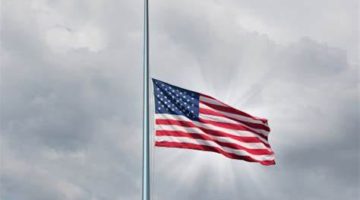H.G. Wells published “The War That Will End War” in August 1914, the title became a catch phrase for the bloody conflict that was named “World War I” — even though most of the world was not involved — and it was deemed “the war to end all wars.” The slaughter ended four years later, in 1918, after between 15 million and 22 million people were killed, including 10 million civilians, and 23 million others were wounded. It happened because an Austria-Hungary archduke was assassinated.
Two years later, the League of Nations was created, on Jan. 10, 1920, by the Treaty of Versailles, and 41 countries attended the first general assembly that Nov. 15. The League’s mandate was “to promote international cooperation and to achieve peace and security.”
Peace and security did not endure. “World War II” came along, lasting six years, from 1939 to 1945, and between 50 million and 85 million people were killed, including more than 38 million civilians. The dead included between 60,000 and 146,000 in Hiroshima and between 60,000 and 80,000 in Nagasaki, the two Japanese cities on which the United States dropped nuclear bombs. This time, it was because Adolf Hitler invaded Poland.
There has been no “world war” since then but 45 internal conflicts in nearly a dozen countries have so far killed nearly 100,000 people. Around two billion have been affected overall, half of them living in poverty. Some 68.5 million have been displaced and more than 111 million have been forced to flee their homes. They include 43 million refugees, 40 percent under age 18, the United Nations High Commissioner for Refugees reported. Some 120 million depend on humanitarian assistance. More than 63,000 refugees died or disappeared during a 10-year period, the International Organization for Migration Missing Migrants Project reported.
The United Nations Organization, successor to the League of Nations, has proven to be powerless to bring an end to the carnage and suffering resulting from these civil wars. Its Security Council, which is charged with maintaining “international peace and security,” is mostly paralyzed because of the five permanent members’ veto. Its main judicial arm, the International Criminal Court (ICC), is empowered to investigate and prosecute crimes against humanity but its effectiveness depends on its member nations’ cooperation.
In fact, 93 of those 124 member countries issued a statement recently demanding that the ICC be allowed to do its job “without intimidation.” They vowed to “preserve its integrity from any political interference and pressure against the court, its officials and those cooperating with it.” The statement came after The Guardian reported that Israel was waging a nine-year surveillance and espionage campaign “to undermine, influence and intimidate the court.”
Also, the United Nations charter expressly forbids interference in the internal affairs of member countries. It is understandable that countries, especially those which were finally able to break free of colonialism, would not consent to their former occupiers being able to control their affairs, especially by sending troops. This has allowed sundry dictators to seize and deploy state power, often violently, to stay in office.
The former colonial powers have seemed content to let the killing fields endure so long as they do not threaten the world order as established especially after World War II. There can really be no other reason for the non-interference shown towards the brutality that has been taking place in some places. The International Rescue Committee (IRC) lists them, in order of desperation, as Sudan, the Occupied Palestinian territory, South Sudan, Burkina Faso, Myanmar (Burma), Mali, Somalia, Niger, Ethiopia and Democratic Republic of the Congo.
They “are home to just 10 percent of the world’s population but account for approximately 86 percent of all people in humanitarian need globally, 75 percent of displaced persons, 70 percent of people suffering from crisis or worse levels of food insecurity — and a growing share of global extreme poverty,” the IRC reported.
This evident reluctance contrasts sharply with the speed with which many major countries rushed to provide weapons and billions of dollars to help Ukraine after Russia’s invasion. The rationale is to dissuade President Vladimir Putin from invading other nations which, unlike Ukraine, are members of the North Atlantic Treaty Organization. Such a move would trigger a wider confrontation, perhaps a “World War III.” Evidently, those colored folks killing one another by the tens of thousands is all right so long as they are no threat to international security.
But there is one threat, as they see it, that demands action: shutting off the influx of millions of refugees. It is reflected in the rise of nativist parties which are now surging in popularity, as seen most recently in France.
Nativists believe that the refugees pose an existential threat to European culture and its very existence – the so-called “replacement theory.” It must be a frightening thought because people of Indigenous, African, Asian and Latin America descent comprise 85 percent of the world’s population of nearly eight billion.
And there is a direct link between European and American nativists, such as former President Donald Trump’s adviser Steve Bannon. The Nation reported he has been trying to build a network for a “global populist movement” and a “gladiator school for culture warriors.”
In fact, much of the inspiration for the growth of nativism comes from the United States, where some people have for years called for a crackdown on refugees. They claim, as Trump put it, that refugees would “poison the blood” of the country, which is what Adolph Hitler said about Jews before his regime killed six million of them. What is distinct about the United States is that, while European powers maintained colonies abroad, here, 40 million descendants of formerly enslaved Africans are now part of the nation, not refugees — a fact which millions of Americans still refuse to acknowledge. For them, the “blood poisoning” extends beyond just refugees.
American nativists have long planned to do something about it. The U.S. Constitution, drafted originally to protect the interests of a minority group – landowners, all white men -has been amended several times to extend citizenship rights to the entire population. The nativists want to return to the era before then. That is why Trump is so popular, despite lacking the qualities desired in a President. They want to use him as a figurehead — even proclaiming that he is on a divine mission – through whom they can eliminate the safeguards that protect democracy so they can entrench themselves in power and “save America.”
The Project 2025 plan for a possible Trump second term leaves little doubt about can be expected. Underpinning the almost 1,000-page blueprint is demolishing the “deep state” and installing nativists throughout the federal bureaucracy to engineer an extremist reshaping of the United States.
Of course there are many millions of Americans who have not drunk from the Trump chalice. But many of them belong to the Democratic Party, which has shown remarkable inability to make themselves seen and heard, unlike the widespread demonstrations in France against the prospect of a coming autocracy.
There may not be a “world war” taking place now but war as such has never ended and never will because wars are based on economic imperatives and a perceived need to maintain the stranglehold on the world by the real minority, the 14 percent or so of humankind that are not “colored.”
It is no coincidence that, in 2022, global household wealth totaled $454 trillion and half of it was held by millionaires, according to the online publisher Visual Capitalist. Some 41 million of the world’s wealthiest 60 million people live in North America (25 million, of whom 23 million are in the United States) and Europe (16 million).
That, really, is the true bottom line.













No Comment